Recalibrating the Genetics and Epidemiology of Colorectal Cancer Consortium (GECCO) Environmental Risk Score for Use in US Veterans
IF 3.7
3区 医学
Q2 ONCOLOGY
引用次数: 0
Abstract
Background: Risk for colorectal cancer (CRC) may accumulate through multiple environmental factors. Understanding their effects, along with genetics, age and family history, could allow improvements in clinical decisions for screening protocols. We aimed to extend previous work by recalibrating an environmental risk score (e-Score) for CRC among a sample of US Veteran participants of the Million Veteran Program (MVP). Methods: Demographic, lifestyle, and CRC data from 2011-2022 were abstracted from survey responses and health records of 227,504 male MVP participants. Weighting for each environmental factor’s effect size was recalculated using VA training data to create a recalibrated e-Score. This recalibrated score was compared with the original weighted e-Score in a validation sample of 113,752 (n cases=590). Nested multiple logistic regression models tested associations between quintiles for recalibrated and original e-Scores. Likelihood Ratio Tests were used to compare model performance. Results: Age (p<0.0001), education (p<0.0001), diabetes (p<0.0001), physical activity (p<0.0001), smoking (p<0.0001), NSAID use (p<0.0001), calcium (p=0.015), folate (p=0.020), and fruit consumption (p=0.019) were significantly different between CRC case and control groups. In the validation sample, the recalibrated e-Score model significantly improved the base model performance (p<0.001), but the original e-Score model did not (p=0.07). The recalibrated e-Score model quintile 5 was associated with significantly higher odds for CRC compared with quintile 1 (Q5 vs Q1: 1.79, 95% CI: 1.38-2.33). Conclusions: Multiple environmental factors, and the recalibrated e-Score quintiles were significantly associated with CRC cases. Impact: A recalibrated, Veteran-specific e-Score could be used to help personalize CRC screening and prevention strategies.重新校准用于美国退伍军人的结直肠癌遗传与流行病学联合会(GECCO)环境风险评分
背景:患结直肠癌(CRC)的风险可能是由多种环境因素累积而成的。了解这些因素以及遗传、年龄和家族史的影响,可以改进筛查方案的临床决策。我们的目的是通过重新校准百万退伍军人计划(MVP)美国退伍军人参与者样本中的 CRC 环境风险评分(e-Score)来扩展之前的工作。方法:从 227,504 名 MVP 男性参与者的调查回复和健康记录中抽取了 2011-2022 年的人口统计学、生活方式和 CRC 数据。利用退伍军人事务部的培训数据重新计算了每个环境因素效应大小的权重,以创建一个重新校准的 e-Score。在 113,752 个验证样本(n 个病例=590)中,将重新校准后的得分与原始加权 e-Score 进行比较。嵌套的多元逻辑回归模型测试了重新校准后的 e-Score 和原始 e-Score 的五分位数之间的关联。使用似然比检验比较模型的性能。结果年龄(p<0.0001)、教育程度(p<0.0001)、糖尿病(p<0.0001)、体力活动(p<0.0001)、吸烟(p<0.0001)、使用非甾体抗炎药(p<0.0001)、钙(p=0.015)、叶酸(p=0.020)和水果摄入量(p=0.019)在 CRC 病例组和对照组之间存在显著差异。在验证样本中,重新校准的 e-Score 模型明显改善了基础模型的性能(p<0.001),但原始 e-Score 模型没有改善(p=0.07)。重新校准后的 e-Score 模型五分位数 5 与五分位数 1 相比,患 CRC 的几率明显更高(Q5 vs Q1:1.79,95% CI:1.38-2.33)。结论多种环境因素和重新校准的 e-Score 五分位数与 CRC 病例显著相关。影响:重新校准的退伍军人特异性 e-Score 可用于帮助制定个性化的 CRC 筛查和预防策略。
本文章由计算机程序翻译,如有差异,请以英文原文为准。
求助全文
约1分钟内获得全文
求助全文
来源期刊

Cancer Epidemiology Biomarkers & Prevention
医学-公共卫生、环境卫生与职业卫生
CiteScore
6.50
自引率
2.60%
发文量
538
审稿时长
1.6 months
期刊介绍:
Cancer Epidemiology, Biomarkers & Prevention publishes original peer-reviewed, population-based research on cancer etiology, prevention, surveillance, and survivorship. The following topics are of special interest: descriptive, analytical, and molecular epidemiology; biomarkers including assay development, validation, and application; chemoprevention and other types of prevention research in the context of descriptive and observational studies; the role of behavioral factors in cancer etiology and prevention; survivorship studies; risk factors; implementation science and cancer care delivery; and the science of cancer health disparities. Besides welcoming manuscripts that address individual subjects in any of the relevant disciplines, CEBP editors encourage the submission of manuscripts with a transdisciplinary approach.
 求助内容:
求助内容: 应助结果提醒方式:
应助结果提醒方式:


